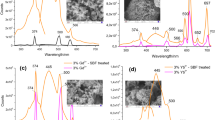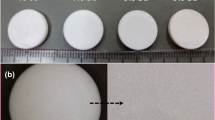Abstract
Rare earth-containing bioactive glasses are promising materials for biomedical applications like brachytherapy, luminescence-based imaging, magnetic resonance imaging, among others, due to the electronic configuration of rare earth. Although studies of such glasses have continuously been increasing, they still have been poorly studied as biomaterials. In this work, we studied the influence of gadolinium and ytterbium on the structure of bioactive glasses and iron-based bioactive glasses. The glasses were obtained by melt quenching, and their structures were characterized by X-ray diffraction, nuclear magnetic resonance, X-ray photoelectron spectroscopy, electron paramagnetic resonance and scanning electron microscopy. The results showed that the addition of rare earth elements in the glass structure creates more non-bridging oxygen bonds in the silicate network, to satisfy the condition of octahedral coordination of the rare earth ions. An observed Q3 → Q2 + Q1 depolymerization of the glass network is a factor that could favor bioactivity. In conclusion, our experimental data address the bioactive behavior of rare earth-containing glasses to an increased concentration of non-bridging oxygen bonds and a more fragmented network.





Similar content being viewed by others
References
Marchi J (2016) Biocompatible glasses: from bone regeneration to cancer treatment, 1st edn. Springer International Publishing, Cham. https://doi.org/10.1007/978-3-319-44249-5
Lopez TCC, Diniz IMA, Ferreira LS, Marchi J, Borges R, de Cara SPHM, D’Almeida-Couto R, Marques MM (2017) Bioactive glass plus laser phototherapy as promise candidates for dentine hypersensitivity treatment. J Biomed Mater Res Part B Appl Biomater 105:107–116. https://doi.org/10.1002/jbm.b.33532
Borges R, Kai KC, Marchi J (2016) Biocompatible glasses for controlled release technology. In: Marchi J (ed) Biocompatible glasses—from bone regeneration to cancer treatment, 1st edn. Springer International, Cham, pp 285–315. https://doi.org/10.1007/978-3-319-44249-5
Aspasio RD, Borges R, Marchi J (2016) Biocompatible Glasses for cancer treatment. In: Marchi J (ed) Biocompatible glasses—from bone regeneration to cancer treatment, 1st edn. Springer International, Cham, pp 249–265. https://doi.org/10.1007/978-3-319-44249-5
Mokhtari S, Skelly KD, Krull EA, Coughlan A, Mellott NP, Gong Y, Borges R, Wren AW (2017) Copper-containing glass polyalkenoate cements based on SiO2–ZnO–CaO–SrO–P2O5 glasses: glass characterization, physical and antibacterial properties. J Mater Sci 52:8886–8903. https://doi.org/10.1007/s10853-017-0945-5
Sadeghi M, Taghdiri F, Hosseini SH, Tenreiro C, Tenreiro C (2010) Monte Carlo calculated TG-60 dosimetry parameters for the β− emitter 153Sm brachytherapy source. Med Phys 5370:5369–5395. https://doi.org/10.1118/1.3488971
Hosseini SH, Enferadi M, Sadeghi M (2013) Dosimetric aspects of Ho brachytherapy biodegradable glass seed. Appl Radiat Isot 73:109–115. https://doi.org/10.1016/j.apradiso.2012.12.002
Roberto WS, Pereira MM, Campos TPR (2003) Dosimetric analysis and characterization of radioactive seeds produced by the sol-gel method 242:579–582. https://doi.org/10.4028/www.scientific.net/KEM.240-242.579
Campos TPR, Andrade JPL, Costa IT, Silva CHT (2008) Study of the Sm-153 seeds degradation and evaluation of the absorbed dose in rabbit’s liver implants. Prog Nucl Energy 50:757–766. https://doi.org/10.1016/j.pnucene.2008.01.007
El-Kady AM, Ali AF, Rizk RA, Ahmed MM (2012) Synthesis, characterization and microbiological response of silver doped bioactive glass nanoparticles. Ceram Int 38:177–188. https://doi.org/10.1016/j.ceramint.2011.05.158
Taghdiri F, Sadeghi M, Hosseini SH, Athari M (2011) TG-60 dosimetry parameters calculation for the β− emitter 153Sm brachytherapy source using MCNP, Iran. J Radiat Res 9:103–108
Khorshidi A, Ahmadinejad M, Hosseini SH, N-particle C (2015) Evaluation of a proposed biodegradable 188Re source for brachytherapy application: a review of dosimetric parameters. Medicine (Baltimore) 94:1–7. https://doi.org/10.1097/MD.0000000000001098
Roberto WS, Pereira MM, Campos TPR (2003) Structure and dosimetric analysis of biodegradable glasses for prostate cancer treatment. Artif Organs 27:432–436
Fan Y, Yang P, Huang S, Jiang J, Lian H, Lin J (2009) Luminescent and mesoporous europium-doped bioactive glasses (MBG) as a drug carrier. J Phys Chem C 113:7826–7830. https://doi.org/10.1021/jp900515x
Huang S, Kang X, Cheng Z, Ma P, Jia Y, Lin J (2012) Electrospinning preparation and drug delivery properties of Eu3+/Tb3+ doped mesoporous bioactive glass nanofibers. J Colloid Interface Sci 387:285–291. https://doi.org/10.1016/j.jcis.2012.08.004
Nicolini V, Varini E, Malavasi G, Menabue L, Menziani MC, Lusvardi G, Pedone A, Benedetti F, Luches P (2016) The effect of composition on structural, thermal, redox and bioactive properties of Ce-containing glasses. Mater Des 97:73–85. https://doi.org/10.1016/j.matdes.2016.02.056
Leonelli C, Lusvardi G, Malavasi G, Menabue L, Tonelli M (2003) Synthesis and characterization of cerium-doped glasses and in vitro evaluation of bioactivity. J Non Cryst Solids 316:198–216. https://doi.org/10.1016/S0022-3093(02)01628-9
Christie JK, Malik J, Tilocca A (2011) Bioactive glasses as potential radioisotope vectors for in situ cancer therapy: investigating the structural effects of yttrium. Phys Chem Chem Phys 13:17749–17755. https://doi.org/10.1039/c1cp21764j
Christie JK, Tilocca A (2012) Integrating biological activity into radioisotope vectors: molecular dynamics models of yttrium-doped bioactive glasses. J Mater Chem 22:12023–12031. https://doi.org/10.1039/c2jm31561k
Tilocca A (2015) Realistic models of bioactive glass radioisotope vectors in practical conditions: structural effects of ion exchange. J Phys Chem C 119:17442–27448. https://doi.org/10.1021/acs.jpcc.5b07804
Zambanini T, Borges R, Delfino GP, Sousa IP, Marques MM, Marchi J (2018) Dissolution, bioactivity behavior and cytotoxicity of rare earth-containing bioactive glasses (RE = Gd, Yb). Int J Appl Ceram Technol. (Accepted for publication)
Loft SM, Coles IP, Dale RG (1992) The potential of ytterbium 169 in brachytherapy: a brief physical and radiobiological assessment. Br J Radiol 65:252–257. https://doi.org/10.1259/0007-1285-65-771-252
Cornejo CR (2016) Luminescence in rare earth ion-doped oxide compounds. In: Thirumalai J (Ed) Luminescence—an outlook on the phenomena and their applications, 1st edn. IntechOpen, London. https://doi.org/10.5772/65185
Hu F, Wei X, Qin Y, Jiang S, Li X, Zhou S, Chen Y, Duan C-K, Yin M (2016) Yb3+/Tb3+ co-doped GdPO4 transparent magnetic glass–ceramics for spectral conversion. J Alloys Compd 674:162–167. https://doi.org/10.1016/j.jallcom.2016.03.040
Cannas M, Indemini E, Krajewski A, Ravaglioli A, Contoli S (1990) In vitro observations of iron-doped bioactive glasses. Biomaterials 1:281–285
Borges R, da Silva AC, Marchi J (2012) Evaluation of the bioactivity behavior of a 48 wt% SiO2 bioglass through experiments in simulated body fluid. Mater Sci Forum 727–728:1238–1242. https://doi.org/10.4028/www.scientific.net/MSF.727-728.1238
Nesbitt HW, Bancroft GM, Henderson GS, Ho R, Dalby KN, Huang Y, Yan Z (2010) Bridging, non-bridging and free (O2−) oxygen in Na2O–SiO2 glasses: an X-ray photoelectron spectroscopic (XPS) and nuclear magnetic resonance (NMR) study. J Non Cryst Solids 357:170–180. https://doi.org/10.1016/j.jnoncrysol.2010.09.031
Lockyer MWG, Holland D, Dupree R (1995) NMR investigation of the structure of some bioactive and related glasses. J Non Cryst Solids 188:207–219. https://doi.org/10.1016/0022-3093(95)00188-3
Rada S, Dan V, Rada M, Culea E (2010) Gadolinium-environment in borate–tellurate glass ceramics studied by FTIR and EPR spectroscopy. J Non Cryst Solids 356:474–479. https://doi.org/10.1016/j.jnoncrysol.2009.12.011
Malchukova E, Boizot B, Ghaleb D, Petite G (2006) β-Irradiation effects in Gd-doped borosilicate glasses studied by EPR and Raman spectroscopies. J Non Cryst Solids 352:297–303. https://doi.org/10.1016/j.jnoncrysol.2005.11.003
Eniu D, Gruian C, Vanea E, Patcas L, Simon V (2015) FTIR and EPR spectroscopic investigation of calcium-silicate glasses with iron and dysprosium. J Mol Struct 1084:23–27. https://doi.org/10.1016/j.molstruc.2014.12.020
Shankhwar N, Kothiyal GP, Srinivasan A (2014) Understanding the magnetic behavior of heat treated CaO–P2O5–Na2O–Fe2O3–SiO2 bioactive glass using electron paramagnetic resonance studies. Phys B Condens Matter 448:132–135. https://doi.org/10.1016/j.physb.2014.03.070
Pedone A, Charpentier T, Malavasi G, Menziani MC (2010) New insights into the atomic structure of 45S5 bioglass by means of solid-state NMR spectroscopy and accurate first-principles simulations. Chem Mater 22:5644–5652. https://doi.org/10.1021/cm102089c
Iftekhar S, Pahari B, Okhotnikov K, Jaworski A, Stevensson B, Grins J, Edén M (2012) Properties and structures of RE2O3–Al2O3–SiO2 (RE = Y, Lu) glasses probed by molecular dynamics simulations and solid-state NMR: the roles of aluminium and rare-earth ions for dictating the microhardness. J Phys Chem C 116:18394–18406. https://doi.org/10.1021/jp302672b
Marchi J, Morais DS, Schneider J, Bressiani JC, Bressiani AHA (2005) Characterization of rare earth aluminosilicate glasses. J Non Cryst Solids 351:863–868. https://doi.org/10.1016/j.jnoncrysol.2005.01.078
Hill RG, Brauer DS (2011) Predicting the bioactivity of glasses using the network connectivity or split network models. J Non Cryst Solids 357:3884–3887. https://doi.org/10.1016/j.jnoncrysol.2011.07.025
Acknowledgements
The authors gratefully acknowledge Profa. Dra. Marcia Spinace and her graduate student MSc. Asaph for their support on the FTIR analysis, and Prof. Dr. Carlos Rettori and Dr. Michael Cabrera-Baez for their support on the EPR measurements and analysis. We are grateful to the Centro em Ciência e Tecnologia dos Materiais at IPEN/CNEN São Paulo, Brazil, for their support on the scanning electron microscopy, and to Central Experimental Multiusuário CEM/UFABC, Brazil, for the facilities support. The authors also appreciate the financial support provided by UFABC and Brazilian Founding Agencies such as FAPESP (2014/19308-8, 2013/07793-6, 2016/16512-0 and 2011/19924-2) and CNPq (308142/2015-2, 130637/2016-5, 402066/2016-2 and 08142/2015-2).
Author information
Authors and Affiliations
Corresponding author
Ethics declarations
Conflict of interest
The authors do not have any conflict of interest.
Additional information
Publisher's Note
Springer Nature remains neutral with regard to jurisdictional claims in published maps and institutional affiliations.
Rights and permissions
About this article
Cite this article
Borges, R., Schneider, J.F. & Marchi, J. Structural characterization of bioactive glasses containing rare earth elements (Gd and/or Yb). J Mater Sci 54, 11390–11399 (2019). https://doi.org/10.1007/s10853-019-03715-1
Received:
Accepted:
Published:
Issue Date:
DOI: https://doi.org/10.1007/s10853-019-03715-1




